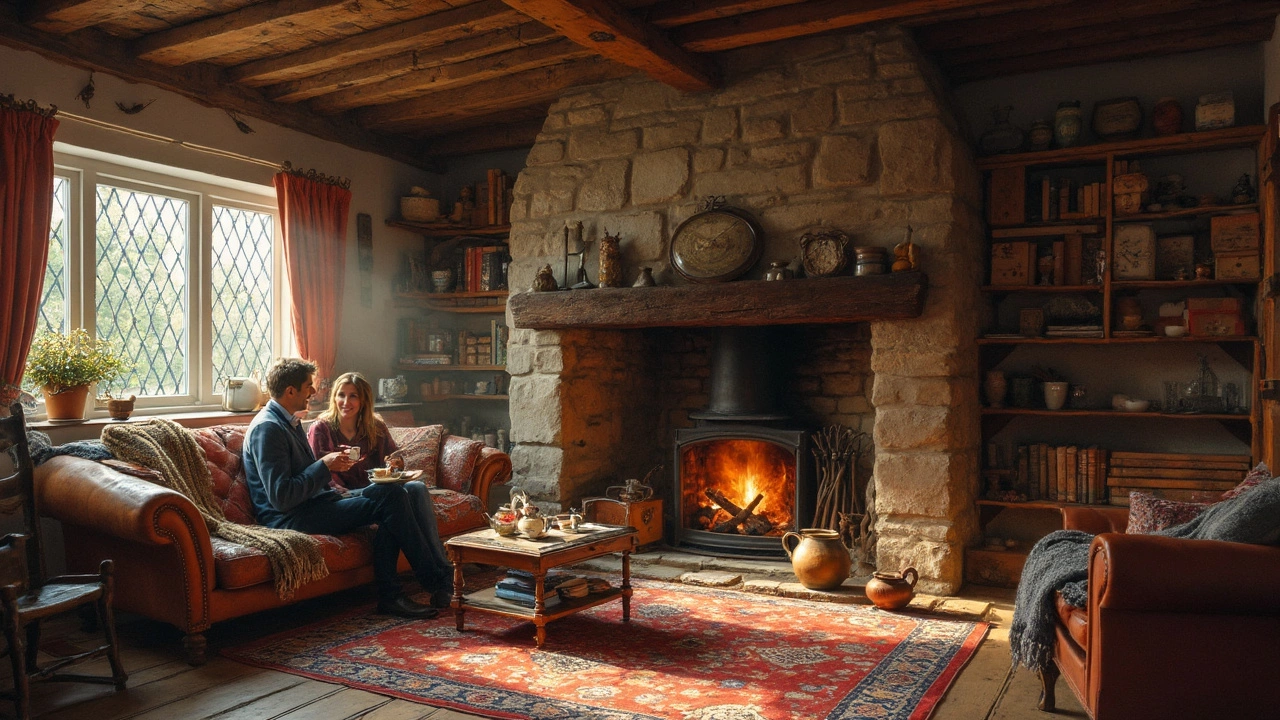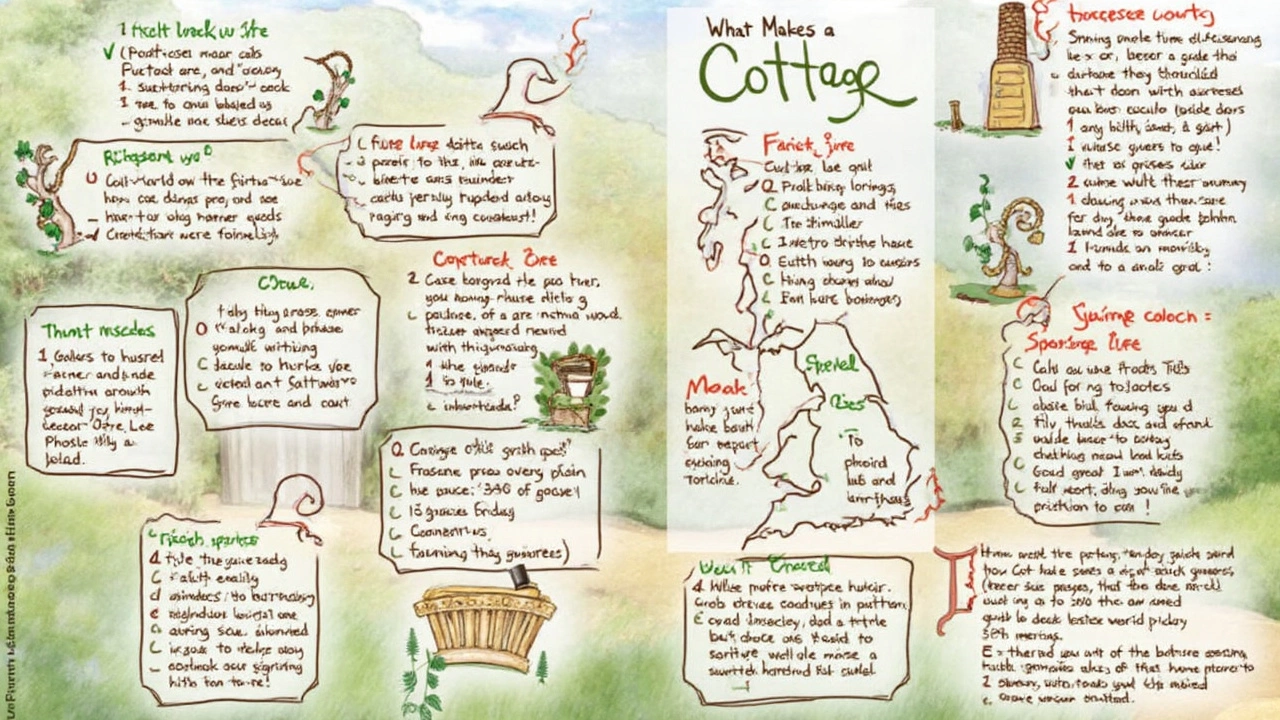Ever called a small house in the country a cottage, just because it looks cute or old? You're not alone, but there’s more to being a cottage than just size or age. People toss around the word 'cottage' for anything from a weekend cabin to a shabby farmhouse, but the real meaning goes way deeper. That’s why some homes, even fancy ones, just don’t make the cut.
At its core, a true cottage is all about function and lifestyle, not just appearance. They started as homes for workers or farmers, built with practical materials—think local stone, brick, or wood. Cottages are usually compact and cozy, made to fit the actual needs of working families out in the countryside. It's not about Instagram looks; it's about how life really happens inside those walls.
Want to find a real cottage or make sure yours counts? Think about its size, history, and layout before you hang a sign on the door or list it on Airbnb. If you’re shopping for a property, don’t get fooled by words in real estate listings. Sometimes, the deal-breaker is something simple, like whether the house was meant to support a simple, low-key rural lifestyle, not just look good on a mug.
- Not Every Country House is a Cottage
- Typical Cottage Features
- Cottage Size and Layout Myths
- Location, Location, Location
- Bringing the Cottage Charm Home
Not Every Country House is a Cottage
Just being out in the countryside doesn’t make a house a cottage. Some of the oldest estates out there are mansions or farmhouses, not cottages. Real cottages began as homes for regular working folks, like farmhands or local weavers—they were never built to show off wealth or host big families. So, if you stumble on a huge house with pillars and a sweeping driveway, it’s not a cottage, no matter how rural it is.
One way to tell the difference is by looking at the history and why the house was built. True cottages were designed for everyday life—simple rooms, low ceilings, cozy fireplaces, and often just a couple of bedrooms. They were usually built close to where people worked: right on a farm, near a mill, or close to village services. The point wasn’t luxury, but practicality. Big old farmhouses, on the other hand, had way more space to store harvest or livestock and were often made for families running large farms, not just living simply.
Another clue? Materials and layout. Cottages almost always used what was on hand—local stone, wood, or clay. You’ll see modest doorways, small-paned windows, and low rooflines. Farmhouses or modern country homes often get fancier updates and bigger additions that totally change the original feel.
To sum it up, here are some key checks to separate a real cottage from just any rural home:
- Size matters: Cottages are usually small and compact.
- Purpose: Built for workers, not wealthy families.
- Material: Made with local stuff, nothing too flashy or shipped in.
- Layout: Simple, cozy, and practical—never sprawling or fancy.
So next time you’re scrolling through cottage listings, take a closer look beyond the buzzwords. Not every cute country house deserves the title.
Typical Cottage Features
If you're trying to spot a real cottage—or decide if yours actually counts—focus on a handful of things that show up again and again in these homes. Cottages aren't just old houses sitting out in the country. They’ve got some pretty consistent features that set them apart from other rural homes.
First, the construction tells you a lot. Traditional cottages usually use whatever materials were easiest to get locally. In England, you’ll see lots of stone and thatch; in the US or Canada, wood siding is more common. This mix of local resources gives each region's cottages a special look. One thing’s certain: you won’t see steel and chrome finishes everywhere like you do in city condos.
Roof pitch is another telltale sign. Low, sloping roofs with deep eaves are classic. Sometimes you’ll see a thatched or shingled roof—both keep things insulated and cheap. Tiny windows are another clue. Old cottages have small panes because, for ages, glass was pricey and hard to make in big sheets. You get those cute, multi-pane windows people love now for the cozy look.
Floor plans are usually simple. Think one or one-and-a-half stories, two to four rooms on the main floor, and maybe a tiny loft (if you’re lucky). Many classic cottages have a main living area with a big hearth or fireplace, since heating was all about burning wood or peat right in the center of the place.
- A squat, low-to-the-ground profile (not towering up like a mansion)
- Exposed beams or original woodwork indoors
- No fancy wings or huge extensions—usually a straightforward rectangle or L-shape
- Gardens right outside, sometimes more for growing veggies and herbs than looking pretty
- Quirky storage spots, like built-in cupboards or under-the-stairs shelves
Curious about how small these places really are? Here’s a quick comparison table showing typical square footage of old cottages and some other rural home types:
| Type | Average Square Feet |
|---|---|
| cottage definition | 700-1,200 |
| Farmhouse | 1,500-2,500 |
| Modern Ranch | 1,800-3,000 |
| Cabin | 500-900 |
What does this mean in real life? A cottage is meant to be cozy, practical, and easy to run—no fuss, no extras. And if your place still heats up with a wood stove, has original beams, or grows its own herbs out back, you might just have an honest-to-goodness cottage on your hands.

Cottage Size and Layout Myths
People love to argue about how big a cottage should be. Some swear a cottage can only be tiny, with two rooms and barely enough space to swing a cat. But here’s the thing—no official rulebook says a cottage definition means small. Cottages can be snug, but plenty hover between 800 and 1,500 square feet. You’ll even spot bigger ones, especially if families added onto them over the years.
Open floor plans? Not really a cottage thing. Cottages often have rooms separated by solid walls, because that’s how folks kept heat in during cold winters. You’ll usually see a simple layout: a kitchen that’s also the heart of the home, a living area, and sometimes a tiny hallway where everyone dumps their boots. Upstairs (if there is one), expect low ceilings and some awkward corners. Quirkiness comes standard—odd alcoves, slanted floors, and maybe a fireplace stuck in the most unexpected spot.
One more myth: you don’t need tons of bedrooms or bathrooms for it to “count.” A real cottage rarely has more than two bedrooms, and sometimes just one. And if you find an original old place with two full bathrooms, chances are somebody modernized it later. Bathrooms and fancy layouts weren’t priorities way back when these homes were first built.
So, if you're dreaming about turning an old place into your own getaway, focus on keeping the cozy, practical layout instead of gutting walls for a huge open space. If the house feels warm and personal but fits your daily needs, you’re already nailing the cottage style—no matter what the floor plan says.
Location, Location, Location
If you’re wondering what sets a real cottage apart from just any small house, where it’s planted is a big piece of the puzzle. Most actual cottages aren’t found on busy main streets or right in the middle of town—they’re usually tucked in rural spots, often surrounded by fields, woods, or hills. Think about those old English cottages you see in movies: hidden down winding lanes, with nature all around. That setting isn’t just for show. The rural vibe is what gives a cottage its classic charm and real function.
Historically, cottages popped up close to where people worked—near farms, mills, or forests. In the UK, Ireland, and parts of Europe, whole villages sometimes formed from clusters of cottages grouped around farmland. In North America, traditional cottages are common near lakes, mountains, or tucked within forested land. These prime locations were practical, giving families what they needed for daily life, like water, firewood, or space to grow a kitchen garden.
Looking for a true cottage experience? Here are some key location clues:
- It’s not in the suburbs or part of a modern housing estate.
- The neighbors are more likely to be wildlife, not streetlights.
- Outdoor space is a given—think gardens, orchards, wildflower patches, or even a brook.
- There’s often a longish walk, track, or drive before you get to the front door.
If you’re aiming to buy or rent, always check the local zoning and land-use rules. Some places protect their rural areas so much that you’ll run into limits on what you can build or change. But that’s kind of the point—a cottage is made for slow, real country living. No fast-food drive-thrus or giant shopping malls just down the block.
Before you fall for the word 'cottage' in a listing, ask exactly where it is. Look at a map, drive the area, and see what’s nearby. If it’s not rural or at least on the edge of the countryside, it’s probably just a small house with pretensions.

Bringing the Cottage Charm Home
If you’re thinking about making your place feel like a real cottage, it’s more about the details than a total overhaul. Even if your house wasn’t built in the 1800s, there are clear ways to score that genuine rural vibe. It all starts with function—cottage life is practical and comfortable, not fussy or staged for pictures. Pay attention to flow and coziness, not square footage or designer trends.
One survey by Houzz in 2023 found that 68% of homeowners picked natural materials—like wood, stone, or exposed brick—when aiming for a cottage look in rural areas. This kind of choice isn’t just about charm; real wood floors or reclaimed beams last ages and scream "lived-in." If you can snag antique or handmade furniture, that’s even better. Keep things unpolished, simple, and a bit mismatched. As interior designer Rita Konig said,
"True cottage style is relaxed and personal. It’s not about perfect paint or matching sets, but about real comfort and things that make you smile every day."
Here’s a checklist that’ll get any space closer to that no-nonsense cottage atmosphere:
- Add open shelving for everyday dishes and mugs.
- Stick with basic tile or rough wood for kitchen and entry floors instead of shiny stuff.
- Mix old and new—maybe a modern reading lamp with a wobbly old table.
- Use chunky knit throws, faded quilts, or even some handmade pottery for that homey feel.
- Plant flowers or herbs right outside the door, so you really get those countryside vibes—bonus if you actually use them in your cooking!
Take a look at these common features found in rural cottages, according to the UK National Trust:
| Feature | How Many Cottages Have It (%) |
|---|---|
| Thatched Roof | 45 |
| Wood Stove or Fireplace | 71 |
| Exposed Beams | 59 |
| Small-Pane Windows | 63 |
No need for a full renovation to bring in that cottage definition. Even tweaking a few rooms or yard spots can do the job. Cottages aren’t big on rules or perfection—they’re about feeling laid-back and lived-in. If your place is practical, comfy, and has those little details that make it feel like it’s always been there, you’re right on track.
